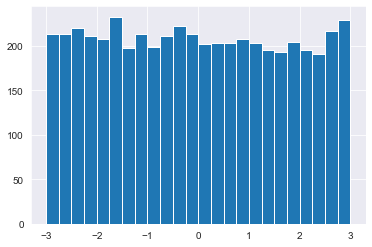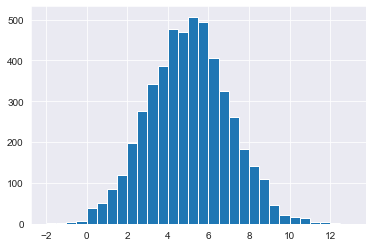Code
# Import seaborn with alias sns
import pandas as pd
import seaborn as sns
import numpy as np
# Import matplotlib.pyplot with alias plt
import matplotlib.pyplot as pltkakamana
January 8, 2023
Get a better understanding of what sampling is and why it is so powerful. Additionally, We will learn about the problems associated with convenience sampling and what the difference between true randomness and pseudo-randomness is.
This Introduction to sampling is part of Datacamp course: Introduction to sampling
This is my learning experience of data science through DataCamp
Population parameter: It is a calculation on population dataset Points vs. flavor: population pts_vs_flavor_pop = coffee_ratings[[“total_cup_points”, “flavor”]] np.mean(pts_vs_flavor_pop[‘total_cup_points’])
Point estimate: Or sample statistic is a calculation made on sample dataset Points vs. flavor: 10 row sample pts_vs_flavor_samp = pts_vs_flavor_pop.sample(n=10) cup_points_samp = coffee_ratings[‘total_cup_points’].sample(n=10) np.mean(cup_points_samp)
The purpose of this exercise is to explore Spotify song data. There are over 40,000 rows in this population dataset, each representing a song. These columns include the title of the song, the artists who performed it, the release year, and attributes of the song, such as its duration, tempo, and danceability. To begin, you should examine the durations.
The Spotify dataset will be sampled and the mean duration of the sample will be compared with the mean duration of the population.
| acousticness | artists | danceability | duration_ms | duration_minutes | energy | explicit | id | instrumentalness | key | liveness | loudness | mode | name | popularity | release_date | speechiness | tempo | valence | year | |
|---|---|---|---|---|---|---|---|---|---|---|---|---|---|---|---|---|---|---|---|---|
| 0 | 0.97200 | ['David Bauer'] | 0.567 | 313293.0 | 5.221550 | 0.227 | 0.0 | 0w0D8H1ubRerCXHWYJkinO | 0.601000 | 10.0 | 0.110 | -13.441 | 1.0 | Shout to the Lord | 47.0 | 2000 | 0.0290 | 136.123 | 0.0396 | 2000.0 |
| 1 | 0.32100 | ['Etta James'] | 0.821 | 360240.0 | 6.004000 | 0.418 | 0.0 | 4JVeqfE2tpi7Pv63LJZtPh | 0.000372 | 9.0 | 0.222 | -9.841 | 0.0 | Miss You | 51.0 | 2000-12-12 | 0.0407 | 117.382 | 0.8030 | 2000.0 |
| 2 | 0.00659 | ['Quasimoto'] | 0.706 | 202507.0 | 3.375117 | 0.602 | 1.0 | 5pxtdhLAi0RTh1gNqhGMNA | 0.000138 | 11.0 | 0.400 | -8.306 | 0.0 | Real Eyes | 44.0 | 2000-06-13 | 0.3420 | 89.692 | 0.4790 | 2000.0 |
| 3 | 0.00390 | ['Millencolin'] | 0.368 | 173360.0 | 2.889333 | 0.977 | 0.0 | 3jRsoe4Vkxa4BMYqGHX8L0 | 0.000000 | 11.0 | 0.350 | -2.757 | 0.0 | Penguins & Polarbears | 52.0 | 2000-02-22 | 0.1270 | 165.889 | 0.5480 | 2000.0 |
| 4 | 0.12200 | ['Steve Chou'] | 0.501 | 344200.0 | 5.736667 | 0.511 | 0.0 | 4mronxcllhfyhBRqyZi8kU | 0.000000 | 7.0 | 0.279 | -9.836 | 0.0 | 黃昏 | 53.0 | 2000-12-25 | 0.0291 | 78.045 | 0.1130 | 2000.0 |
acousticness artists \
7874 0.66400 ['The Walters']
2664 0.01020 ['Beastie Boys', 'Fatboy Slim']
1683 0.00241 ['batta']
14491 0.11400 ['AJ Mitchell', 'Ava Max', 'Sam Feldt']
34495 0.96800 ['Yiruma']
... ... ...
25541 0.85400 ['Andrew Lloyd Webber', 'Patrick Wilson', 'Emm...
904 0.71900 ['Carl Carlton']
26932 0.02910 ['Cory Asbury']
30144 0.14900 ['Twenty One Pilots']
12676 0.35000 ['Grupo Intenso']
danceability duration_ms duration_minutes energy explicit \
7874 0.747 151683.0 2.528050 0.422 0.0
2664 0.650 248507.0 4.141783 0.942 0.0
1683 0.389 145400.0 2.423333 0.988 0.0
14491 0.732 193548.0 3.225800 0.850 0.0
34495 0.287 218293.0 3.638217 0.292 0.0
... ... ... ... ... ...
25541 0.194 294160.0 4.902667 0.119 0.0
904 0.546 153947.0 2.565783 0.828 0.0
26932 0.572 333386.0 5.556433 0.685 0.0
30144 0.550 277013.0 4.616883 0.625 0.0
12676 0.718 219960.0 3.666000 0.529 0.0
id instrumentalness key liveness loudness \
7874 70QqoQ3krRFUHfEzit7vjT 0.002770 7.0 0.3920 -10.008
2664 2WGGxhsc2WtPNkhsXWVcYb 0.000000 1.0 0.1220 -6.609
1683 5V5akuBxKpIlTUPaueNpyy 0.000615 6.0 0.3460 -1.949
14491 2wenGTypSYHXl1sN1pNC7X 0.000002 1.0 0.0388 -5.999
34495 3xr8COed4nPPn6XWZ0iCGr 0.978000 9.0 0.0900 -19.285
... ... ... ... ... ...
25541 5klrh466oGToybceGHPGAX 0.000737 1.0 0.1090 -20.926
904 5i7rT8lbGzjj1n7TTXR5U8 0.030000 4.0 0.3720 -4.771
26932 0rH0mprtecH3grD9HFM5AD 0.000000 6.0 0.0963 -7.290
30144 4IN3imzEuTsiHO6tOwDQu5 0.000000 1.0 0.1610 -8.213
12676 0l7q7H1zYiJ9XHVqim2Uwc 0.000000 7.0 0.1510 -8.769
mode name popularity \
7874 1.0 Goodbye Baby 55.0
2664 1.0 Body Movin' - Fatboy Slim Remix/2005 Remaster 48.0
1683 0.0 chase 61.0
14491 1.0 Slow Dance (feat. Ava Max) - Sam Feldt Remix 72.0
34495 1.0 River Flows in You 62.0
... ... ... ...
25541 1.0 All I Ask Of You 57.0
904 1.0 Everlasting Love 48.0
26932 1.0 Reckless Love 71.0
30144 0.0 Trapdoor 56.0
12676 1.0 Y Volo 45.0
release_date speechiness tempo valence year
7874 2015-10-20 0.0294 111.141 0.5950 2015.0
2664 2005-01-01 0.0754 101.786 0.7850 2005.0
1683 2016-07-27 0.1070 111.975 0.0996 2016.0
14491 2019-10-25 0.0444 124.024 0.3720 2019.0
34495 2011-12-09 0.0541 145.703 0.3460 2011.0
... ... ... ... ... ...
25541 2004-12-10 0.0398 85.698 0.1400 2004.0
904 2009-01-01 0.0394 121.418 0.4010 2009.0
26932 2018-01-26 0.0356 110.698 0.2320 2018.0
30144 2009-12-29 0.0399 149.927 0.3170 2009.0
12676 2001-10-16 0.0325 142.069 0.9440 2001.0
[1000 rows x 20 columns]# Calculate the mean duration in mins from spotify_population
mean_dur_pop = spotify_population['duration_minutes'].mean()
# Calculate the mean duration in mins from spotify_sample
mean_dur_samp = spotify_sample['duration_minutes'].mean()
# Print the means
print(mean_dur_pop)
print(mean_dur_samp)
print("\n Notice that the mean song duration in the sample is similar, but not identical to the mean song duration in the whole population.")3.8521519140900073
3.8048647333333334
Notice that the mean song duration in the sample is similar, but not identical to the mean song duration in the whole population.28889 -6.697
41542 -3.166
24096 -8.327
38021 -5.596
29360 -3.779
...
34958 -7.206
41513 -7.560
28413 -7.113
41429 -6.073
38857 -4.433
Name: loudness, Length: 100, dtype: float64# Calculate the mean of loudness_pop
mean_loudness_pop = np.mean(loudness_pop)
# Calculate the mean of loudness_samp
mean_loudness_samp = np.mean(loudness_samp)
# Print the means
print(mean_loudness_pop)
print(mean_loudness_samp)
print("\n Again, notice that the calculated value (the mean) is close but not identical in each case")-7.366856851353947
-7.385839999999999
Again, notice that the calculated value (the mean) is close but not identical in each caseCollecting data by easiest method is convenience sampling
Sample bias: sample not true representation of population Selection bias
In your previous example, you saw that convenience sampling, which is the collection of data using the simplest method, can lead to samples that are not representative of the population. In other words, the findings of the sample cannot be generalized to the entire population. It is possible to determine whether or not a sample is representative of the population by examining the distributions of the population and the sample



[ 0.46978238 -1.66176314 1.31080161 ... 0.27384823 0.57683707
1.94834767]
[0.37088348 5.46510043 5.6804744 ... 5.06268094 7.1989964 4.26078515]